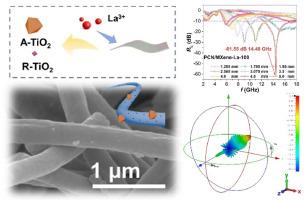稀土诱导的多尺度双相介质分层材料实现了轻量化和宽带电磁响应
IF 11.6
2区 材料科学
Q1 CHEMISTRY, PHYSICAL
引用次数: 0
摘要
轻质、宽频、电磁响应的材料越来越受到人们的关注。稀土改性的高附加值利用为满足这一需求提供了一条有希望的途径。然而,稀土的不可控产生和固有的均匀性限制了电磁波吸收性能的提高。在这里,我们开发了一种有前途的稀土(La)诱导二维(2D) mxene衍生的多尺度,双相介电TiO2策略。该策略实现了零维(0D)大规模锐钛矿(A-TiO2)和小规模金红石(R-TiO2)与一维(1D)多孔氮掺杂碳(PCN)纳米纤维(NFs)的耦合。该策略有效地调节了MXene/PCN NFs的介电行为,促进了0D/1D/2D多能级非均质界面的形成,实现了轻质、宽带和高效的EMW吸收性能,反射损耗(RL)值为−61.55 dB,有效吸收带宽(EAB)为5.7 GHz,薄厚度为1.95 mm。此外,该策略通过静电纺丝和热处理协同工艺实现,有效地将0D TiO2纳米颗粒、la基物质和2D MXene纳米片嵌入到1D PCN NFs中。因此,良好的界面极化、传导损耗和偶极极化是PCN/MXene-La复合材料优异的雷达隐身性能的重要原因。该策略展示了稀土改性材料界面工程和形态工程的方法,为稀土增强电磁行为的合理设计提供了新的范例。本文章由计算机程序翻译,如有差异,请以英文原文为准。

Rare earth-induced multiscale dual-phase dielectric hierarchical materials enabled lightweight and broadband electromagnetic response
The lightweight, broadband, and electromagnetically responsive materials attract growing attention. The high-value-added utilization of rare earth modification offers a promising approach for this need. However, the uncontrollable generation and inherent homogeneity of rare earths limit the enhancement of electromagnetic wave (EMW) absorption performance. Here, we develop a promising rare earth (La)-induced two-dimensional (2D) MXene-derived multiscale, dual-phase dielectric TiO2 strategy. This strategy achieves the coupling of zero-dimensional (0D) large-scale anatase (A-TiO2) and small-scale rutile (R-TiO2) with one-dimensional (1D) porous nitrogen-doped carbon (PCN) nanofibers (NFs). This strategy effectively modulates the dielectric behavior of MXene/PCN NFs and promotes the formation of 0D/1D/2D multilevel heterogeneous interfaces, achieving lightweight, broadband, and highly efficient EMW absorption properties, with a reflection loss (RL) value of −61.55 dB and a wide effective absorption bandwidth (EAB) of 5.7 GHz at thin thickness of 1.95 mm. Furthermore, this strategy was achieved through a synergistic electrospinning and thermal treatment process, effectively embedding 0D TiO2 nanoparticles, La-based species, and 2D MXene nanosheets into 1D PCN NFs. Consequently, favorable interface polarization, conduction loss, and dipole polarization contribute to the outstanding radar stealth properties of the PCN/MXene-La composite. This strategy demonstrates a rare earth-modified approach for interface engineering and morphological engineering of materials, providing a new paradigm for the rational design of rare earth-enhanced electromagnetic behavior.
求助全文
通过发布文献求助,成功后即可免费获取论文全文。
去求助
来源期刊

Carbon
工程技术-材料科学:综合
CiteScore
20.80
自引率
7.30%
发文量
0
审稿时长
23 days
期刊介绍:
The journal Carbon is an international multidisciplinary forum for communicating scientific advances in the field of carbon materials. It reports new findings related to the formation, structure, properties, behaviors, and technological applications of carbons. Carbons are a broad class of ordered or disordered solid phases composed primarily of elemental carbon, including but not limited to carbon black, carbon fibers and filaments, carbon nanotubes, diamond and diamond-like carbon, fullerenes, glassy carbon, graphite, graphene, graphene-oxide, porous carbons, pyrolytic carbon, and other sp2 and non-sp2 hybridized carbon systems. Carbon is the companion title to the open access journal Carbon Trends. Relevant application areas for carbon materials include biology and medicine, catalysis, electronic, optoelectronic, spintronic, high-frequency, and photonic devices, energy storage and conversion systems, environmental applications and water treatment, smart materials and systems, and structural and thermal applications.
 求助内容:
求助内容: 应助结果提醒方式:
应助结果提醒方式:


